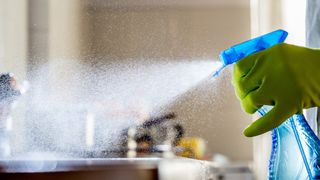Even before stay-at-home measures were introduced, it’s predicted that Americans spent an average of 90% of their time indoors. This used to be spread across schools, workplaces, and our own homes, and the decline in travel as a result of lockdown has contributed to a 30% drop (opens in new tab) in outdoor pollution in some of the most densely populated towns and cities. That doesn’t mean that indoor air pollution has followed suit, however. That 90% figure may be on the conservative side for many who have self-isolated or faced stay-at-home guidance. Findings from Airthings (opens in new tab), who produce smart air quality monitoring devices, suggest that indoor air levels of carbon dioxide and volatile organic compounds (VOCs) increased by 15 to 30% between early March and early May - that’s in homes across several European countries, and the numbers may be even higher here. Put simply, if you’re spending more time at home you’re likely injecting more pollutants into your home’s air. We spoke to the EPA to find out how to decrease indoor air pollution in the wake of COVID-19. “Since, at present, most of us are spending the majority of our time in our homes, it continues to be important to maintain good indoor air quality”, the EPA told us. “There are three basic strategies to improve indoor air quality: source control, improved ventilation, and filtration.” To find out more about advice on improving indoor air quality, check out our guide to how to keep your indoor air pollution levels low (opens in new tab).
Increase in calls to poison hotlines linked to COVID-19 outbreak
One of the main pollutants of indoor air is cleaning products, which have seen an astronomical rise in use in recent months (and for good reason). As coronavirus fears take hold, people are being increasingly vigilant about cleaning door handles, kitchen counters, even their groceries (to find out how to do this safely, read our guide on cleaning your food (opens in new tab)). A CDC report has found that COVID-19 has led to an increase in calls to poison hotlines. It reports “the daily number of calls to poison centers increased sharply at the beginning of March 2020 for exposures to both cleaners and disinfectants.” One anonymous example given includes an unsafe use of chemical disinfectants, leading to a non-life-threatening case of hypoxemia. “An adult woman heard on the news to clean all recently purchased groceries before consuming them. She filled a sink with a mixture of 10% bleach solution, vinegar, and hot water, and soaked her produce. While cleaning her other groceries, she noted a noxious smell described as ‘chlorine’ in her kitchen. She developed difficulty breathing, coughing, and wheezing.”
How to keep indoor air pollution levels low while cleaning
Even if you’re still following guidelines, disinfectants and other cleaning products can create an increase in indoor air pollution for your home. We asked the EPA how best to tackle this: “Using EPA registered cleaning and disinfecting products (opens in new tab) according to their label instructions is the best way to ensure that any IAQ pollution risks are mitigated while still maintaining the effectiveness of the disinfecting product. People should be especially vigilant of any label instructions that recommend wearing personal protective equipment, like gloves or eye protectants, or recommend against mixing certain products. “In general, ventilation during and after cleaning, for example by opening windows or doors, is helpful in reducing exposure to cleaning products and byproducts. This can also reduce risks from particles re-suspended during cleaning, including those potentially carrying viruses. Sensitive individuals should avoid cleaning if they can and consider leaving the room during cleaning if possible.”
